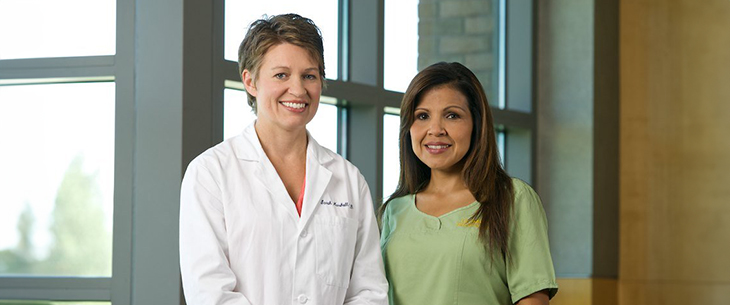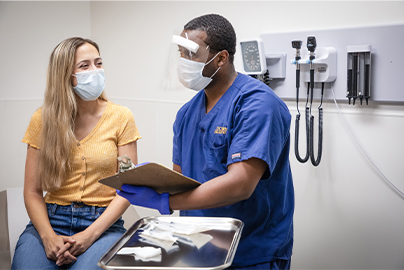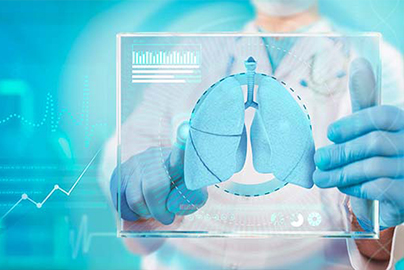Lung Cancer
Patient Care

Lung Cancer Screening
For self-referring patients and referring providers:
- Patients and Providers can call us at 916-703-7050.
- Within the UC Davis Health: Referring providers can send a referral directly through the Electronic Health Record system, MyChart by EPIC.
- Whether you’re a patient seeking guidance or a provider looking to refer a patient, the Lung-LEAD Clinic is here to provide comprehensive support and care.
Lung cancer, the second most common cancer in the United States, is the leading cause of cancer deaths across the nation for both men and women.
If lung cancer is found at an earlier stage, when it is small and before it has spread, it is more likely to be treated successfully and has the best chance for cure. Unfortunately lung cancer usually doesn’t cause noticeable symptoms until it is already at an advanced stage, when treatment becomes difficult. Treatment is most effective during the early stages of lung cancer.
That’s why screening is important. Screening is the process of using tests to detect disease that has not yet shown symptoms. Years ago, chest X-rays were used for lung cancer screening, but now a safer and more accurate test method known as low-dose computed tomography (LDCT) scanning is preferred. Lung cancer screening is recommended for people who smoke or used to smoke, but who don’t have any signs or symptoms. LDCT scans performed at UC Davis Comprehensive Cancer Center can detect cancerous growths in the lungs. Research has shown that LDCT screening is 20% more effective than simple chest X-rays in reducing heavy smokers’ risk of dying from lung cancer.
Who Should Be Screened?
Screening is recommended for people at high risk of lung cancer. These individuals benefit the most from screening. High-risk individuals typically include:
- Current smokers or those who have quit within the past 15 years.
- People ages 50 to 80 (age 77 for patients with primary Medicare insurance) who have a 20 pack-year smoking history. A “pack-year” is calculated by multiplying the number of packs of cigarettes smoked per day by the number of years the person has smoked. A pack consists of 20 cigarettes. Smoking 10 cigarettes a day for a year is calculated as a half pack year. Smoking 20 cigarettes a day for a year is one pack year, and 40 cigarettes in a day for a year totals two pack years.
When Should Screening Occur?
Get checkups annually — If you fall into the high-risk category, doctors recommended having an annual screening. This helps in early detection, even if you feel perfectly healthy.
Why Is Screening Important?
- Early detection — Lung cancer is often more treatable with the best chance for cure in its early stages. Screening can detect lung nodules, which might be early signs of cancer, allowing for timely intervention.
- Improved outcomes — When lung cancer is detected early, more treatment options are available, and the chances of successful treatment are higher.
- Peace of mind — Knowing your lung health status can give you clarity and peace of mind, especially if you’re at high risk.
If you believe you’re at risk or have questions about lung cancer screening, we encourage you to contact the UC Davis Health Lung-LEAD Clinic. Our dedicated team is here to guide you and provide the best care possible.
Lung cancer can grow slowly for years without showing any symptoms, until it reaches advanced stages.
Signs and symptoms of lung cancer include:
- A persistent or worsening cough that doesn’t go away
- Trouble breathing or shortness of breath
- Chest discomfort
- Wheezing
- Streaks of blood in sputum (mucus coughed up from the lungs)
- Hoarseness
- Loss of appetite
- Unexplained weight loss
- Fatigue
Although other illnesses can cause these symptoms, we encourage you to contact your doctor if any of these conditions continue.
Smoking is a known cause of lung cancer. But the condition affects nonsmokers, too. Up who never smoked or who smoked very little receive a lung cancer diagnosis every year.
Smoking and Secondhand Smoke
Smoking is the number one cause of lung cancer, with smokers most at risk. But exposure to secondhand smoke also contributes to lung cancer. Smoke from tobacco products damages cells in your lungs and can turn them cancerous.
Radon
Radon, a natural, radioactive gas, is the leading cause of lung cancer in nonsmokers and the second-leading cause overall. This natural, odorless gas can seep undetected from the ground into your home and other buildings.
Gene Changes
Some people have a gene change (mutation) that makes them more prone to lung cancer. An inherited gene change may run in families. You’re most at risk if a parent or sibling (first degree relative) has lung cancer.
Acquired gene changes also cause lung cancer. This type of gene change occurs over time, usually from exposure to environmental factors like smoking or radon.
Known risk factors for lung cancer include, but are not limited to:
- Smoking cigarettes, pipes or cigars, now or in the past
- Exposure to secondhand smoke
- Prior treatment with radiation therapy to the breast or chest
- Family history of lung cancer
- Breathing in chemical vapors from beryllium, cadmium, silica, vinyl chloride, nickel compounds, chromium compounds, coal products, mustard gas, diesel exhaust or chloromethyl ethers
- Arsenic in drinking water
- Exposure to asbestos, radon, soot or tar
- Living or working in a place with polluted air
People who think they may be at risk of developing cancer should discuss their concerns with their doctor. Learn about Stop Tobacco Program
Physicians often start with imaging tests, such as chest X-rays and CT scans, to check for lung tumors. You may also get an MRI or a combination positron emission tomography (PET) and CT scan to see if cancer has spread outside your lungs (metastatic lung cancer).
Physicians use the following tests to definitively diagnose lung cancer and determine the type:
- Sputum cytology: A lab specialist checks samples of sputum (mucus that you cough up) for cancer cells.
- Bronchoscopy: A physician threads a bronchoscope (flexible tube with a light on the end) through your mouth or nose to examine your lungs. Tiny tools inside the scope help the physician remove tissue or fluid samples to check for cancer cells.
- Needle aspiration/core biopsy: A physician removes tissue from the lung tumor using a hollow needle inserted through your skin. A lab specialist checks the tissue for cancer.
- Robot-assisted bronchoscopy: UC Davis is unique in that we can use complex robotic platforms to diagnose and remove lung cancer in a single surgery. The procedure begins with a CT scan to create a 3D map of your lungs. A software program then generates the safest and most efficient route through the lung to reach nodules or masses.
- Thoracentesis: A physician inserts a needle through your skin to remove fluid between your lungs and chest wall. A lab specialist checks the fluid for cancer.
- Thoracoscopy: A physician inserts a thoracoscope (flexible tube with a light and video camera on the end) through a small chest incision. The camera enables the physician to view your lungs and chest.
After getting a sample, experts in our Department of Pathology and Laboratory Medicine examine it to determine if you have cancer.
Treatment Specialties
Our specially trained lung cancer physicians are dedicated to patient care. The doctors and medical staff members of our lung cancer team gained their expertise through years of specialized training and dedication to advanced patient-centered care. They include:
- interventional pulmonologists, who specialize in minimally invasive procedures for the diagnosis and treatment of lung cancer, airway disorders and pleural diseases
- pulmonary pathologists, who diagnose cancer types from lung tissue samples
- medical oncologists, who are specialists in chemotherapy and immunotherapy
- radiation oncologists, who custom-design the radiation therapy plan for each patient
- thoracic radiologists, who administer individual radiation treatments
- thoracic surgeons, who specialize in chest and lung cancer surgery, and are trained in minimally invasive techniques including robotic surgery
- oncology-trained nurse practitioners, who work with physicians in caring for lung cancer patients
Our clinicians remain mindful of family planning concerns and maintain reproduction preservation options for patients whenever possible.
While many of our patients are treated for cancer using standard treatments, patients can be evaluated and enrolled into innovative and cutting-edge clinical trials.
-

Learn About Clinical Trials
Learn more about lung clinical trialsA clinical trial is a research study meant to help improve current treatments or obtain information on new treatments for patients with cancer. A new approach that is shown to be effective during clinical trials may eventually become a standard treatment.
-

Forms of Therapy
Explore forms of lung cancer treatmentUC Davis Comprehensive Cancer Center performs several types of treatments for lung cancer.

